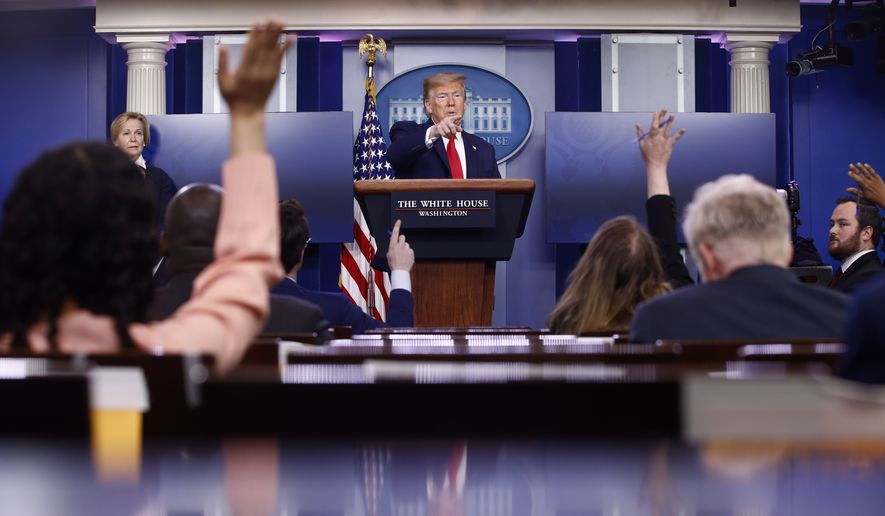OPINION:
According to portrayals in the media and best-selling books, President Trump is befuddled, ignorant and has trouble remembering almost anything. But millions who watch the televised White House coronavirus briefings see a quite different Trump who is obviously in command of thousands of facts, figures and details.
Likewise, the media and Democrats paint Mr. Trump as authoritarian and dictatorial. The White House briefings make it clear Mr. Trump is leaving reopening decisions to the governors of each state.
The media and critics claim Mr. Trump is not compassionate. While he slams critics, we see him in White House briefings repeatedly expressing compassion about the deaths families are experiencing and ordering from the military and private companies whatever it takes to provide hospital beds and needed lifesaving equipment.
The media and Democrats claim Mr. Trump doesn’t listen to experts or look at factual data. In the briefings we see him constantly consulting with doctors and public health experts and deferring to them while rolling out a comeback plan based on progress as measured by data on the spread of the coronavirus pandemic.
The media portray almost anything Mr. Trump says as a meltdown or a rant. In the White House briefings, we see him keeping his cool in the face of snarky, dishonest attacks disguised as questions from reporters.
The critics claim Mr. Trump was slow to react to the pandemic. But as Mr. Trump constantly reminds us in the briefings, he took the unprecedented action on Jan. 31 of ordering a shutdown of travel from China to the United States by non-U.S. citizens and then from Europe, prompting Democrats and media critics to denounce him as xenophobic and racist.
Most of all, while the media claim the White House is in constant chaos, we see the president in the White House briefings leading a complex effort to meld the federal government and the military with state governments and private industry to combat the pandemic.
Seeing is believing, but MSNBC and CNN have shown their true colors by cutting away from portions of the White House briefings, including when Mr. Trump showed video clips of Democratic Govs. Andrew Cuomo of New York and Gavin Newsom of California as well as New York Times reporter Maggie Haberman praising his actions during the pandemic. Disgracefully, the networks justify the blackouts of the clips and updates from the president and public health officials by claiming they are “propaganda.”
Instead of allowing viewers to make up their own minds and obtain valuable medical advice from health care professionals, CNN ran a chyron saying, “Angry Trump turns briefing into propaganda session.”
To be sure, Mr. Trump gives his critics ammunition with some of his exaggerations and tweets. But that is part of his act going back long before he was elected. For my book “The Trump White House,” I interviewed Norma Foerderer, who was Mr. Trump’s top aide for 26 years. She knew Mr. Trump better than anyone on both the business and social side.
When Foerderer joined the Trump Organization in 1981, Mr. Trump had only seven other employees. During her career with him, Foerderer as vice president oversaw almost every aspect of the mogul’s business, including public relations, hiring and firing, and negotiating book deals and contracts. No one knew so well both the personal and business side of Donald Trump.
In the only in-depth interview she ever gave, Foerderer, who has since died, told me there are two Donald Trumps: One is the Trump that appears to the public, making often outrageous comments on television to get attention; the other is the real Trump only insiders know.
“I mean Donald can be totally outrageous, but outrageous in a wonderful way that gets him coverage,” Foerderer told me. “That persona sells his licensed products and his condominiums.”
The private Trump, on the other hand, is “the dearest, most thoughtful, most loyal, most caring man,” Foerderer said. That caring side inspires loyalty and is one of the secrets to his success.
Confirming Foerderer’s point, Mr. Trump wrote in “The Art of the Deal” that “if you are a little different or a little outrageous, or if you do things that are bold or controversial, the press is going to write about you.” Mr. Trump follows his own advice in spades.
Illustrating the difference between the public and private Trump, the Hispanic Chamber of Commerce, which represents 3.2 million business owners, announced during the election campaign that its members would be boycotting all Mr. Trump’s properties following his statements on illegal immigrants and his vow to build a wall across the Mexican border. But Mr. Trump subsequently met privately with Javier Palomarez, the chamber’s CEO.
“There were no bombastic statements of any sorts,” Mr. Palomarez said admiringly on CNN as he left the meeting. “It’s kind of interesting, the dichotomy between the private Donald Trump and the public Donald Trump. He listened a lot more than he spoke.”
Thus, the millions of viewers who watch the White House briefings on the pandemic get to see the real Donald Trump. That Trump is quite different from the myths perpetrated by his detractors.
• Ronald Kessler, a former Washington Post and Wall Street Journal investigative reporter, is the author of “The Trump White House: Changing the Rules of the Game” (Crown Forum).




Please read our comment policy before commenting.